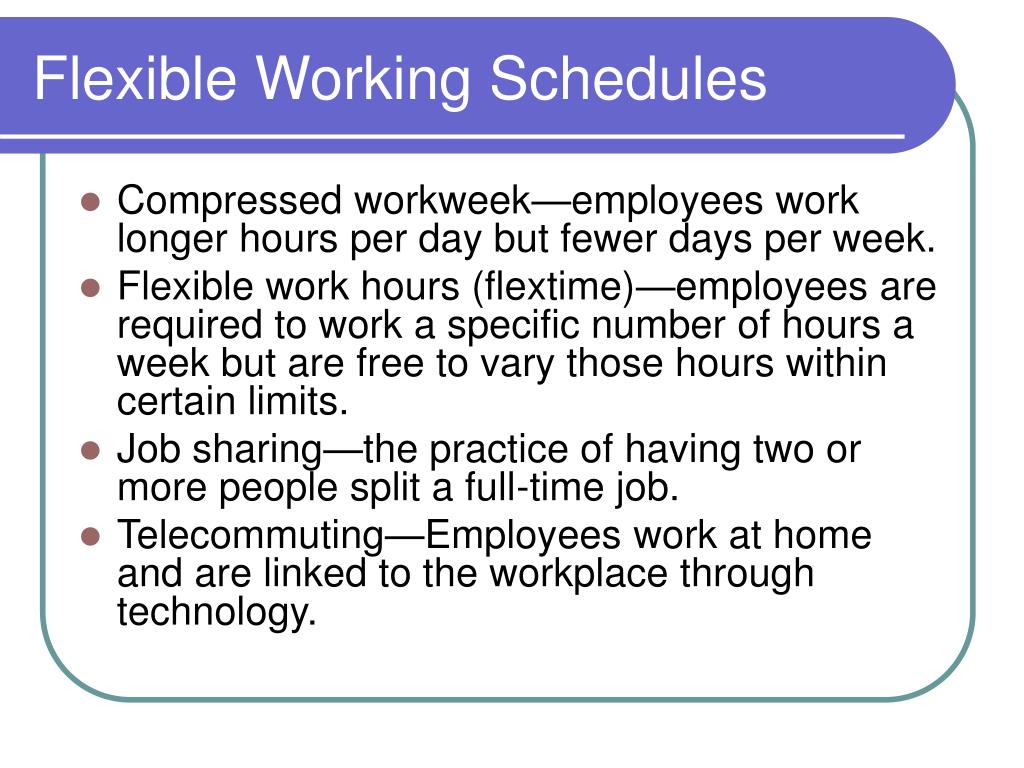
#FLEXTIME ADVANTAGES AND DISADVANTAGES PROFESSIONAL#
However, people with certain executive, administrative, and professional jobs can be exempt from this rule. The typical worker is non-exempt, meaning their employers aren’t exempt from paying overtime. In most cases, employers must pay overtime (150%) wages to people who work more than 40 hours per week. This person could write reports and juggle timesheets in a dedicated “solo work” period at the end of the day. This strategy also allows people to work in private, which can dramatically increase productivity.įor example, a manager who spends most of the day “putting out fires” might enjoy a working a slightly later shift. Your employees might appreciate the option to start and end their work days a couple of hours early (or late). Many workers appreciate the freedom flextime gives them from rush hour traffic. It’s up to you to create the balance of freedom and structure that best suits your business model – and today’s finicky millennial workforce.

This model works well in the manufacturing and customer service sectors – but creates unnecessary structure in many other fields. The whole concept of flextime involves reinventing the “ get paid to show up for a regular shift” model that served companies so well during the industrial revolution. When exploring and setting up flextime opportunities for your team, determine which areas of their schedules need to stay firm – and which can be safely “flexed.” However, this takes place within many real-life limitations. In short, if your office has a flextime policy, you can add/subtract flex hours from your workday. How Does Flex Work?Įvery company that offers flextime puts a new spin on flex, meaning we need to dig a bit deeper to understand this workplace phenomenon. For example, employers often place restrictions on flextime, meaning workers have only a measured amount of freedom. In practice, however, companies define flextime in many ways. This simple flextime definition is a good place to start:Įmployees can choose when to work a set amount of hours. To create jobs with flexible hours, you can follow a number of flextime strategies. To keep your team members on your team, you need to provide the work/life balance this generation craves. Younger workers change jobs much more often than their predecessors – costing employers thousands of dollars per new hire. While these instances should be covered by Worker’s Compensation, some employees have had difficulty proving that the sustained injuries occurred at home during working hours and require consultation from a qualified employment law attorney.Flexibility-and flextime work options matter more and more in the modern workplace.Īs more and more millennials enter the workforce, companies must adopt new employee retention strategies. In addition, if your arrangements involve working from your residence, you may have issues if you get hurt while performing required work at home. Unpaid overtime might be a common issue for employees who use flextime and could result in compensation being needed for hours worked above the established threshold. Occasionally, some employers mistakenly think that using a flexible time arrangement helps them avoid paying overtime pay, but this is not true.Įmployees who are on flextime may still be eligible for overtime. While this was never the intent, it does happen.

These workers are subsequently expected to come into work on short notice. Some employers may attempt to use flexible scheduling to require workers at home be on call.

The benefits for the employee are numerous including work-life balance, family friendly atmosphere, and allow for the rights of employees to be respected. For example, an employee who needs to get kids to daycare at 7:00 am may decide to begin work an hour later.Ĭommuting during off-peak hours also saves money and time, while also allowing businesses to retain key employees who would otherwise leave to meet family obligations. This is highly beneficial for parents because it allows them to work around emergencies or school schedules.
#FLEXTIME ADVANTAGES AND DISADVANTAGES FREE#
This means that employees are free to start and finish at any time they wish to accommodate their schedules. There are a variety of types of flextime available, including core work hours where the employee is only required to be in the office around a core time, usually 10 am to 2 pm. With a flexible schedule, you can give precedence to personal needs such as evening classes or early appointments. Before flextime programs became popular, employees had to schedule all personal activities around their workday.


 0 kommentar(er)
0 kommentar(er)
